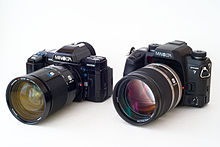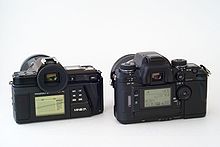- Minolta Maxxum 7000
-
Minolta 7000 
Type 35mm SLR Lens mount Minolta A-mount Focus TTL phase detecting autofocus Exposure Program, Aperture priority, Shutter priority and depth-of-field autoexposure; match-needle manual
6 zone evaluative or 6.5% partial meteringFlash Proprietary Hot shoe only The Minolta MAXXUM 7000 (7000 AF in Europe) 35mm SLR camera was introduced in 1985. It marked a significant milestone in photography as it was the first camera to feature both integrated autofocus (AF) and motorised film advance, the standard configuration for later amateur and professional single lens reflex cameras.
Contents
Overview
Although the Nikon F3AF (1983), Pentax ME F and Chinon CE-5 already had presented autofocus single lens reflex cameras, autofocusing could not be achieved without the use of special motorised AF lenses. The Pentax ME F had focus sensors in the camera body, while the Chinon CE-5 used a lens with built-in active infrared sensors. Nikon already had a camera with integrated motor drive on the market, the N2000 (F-301 in UK), but its autofocus counterpart, the N2020 (F-501 in UK), appeared after the Maxxum/Dynax.
The Minolta 7000 had its AF sensors and the focusing drive inside the camera body, and as a result the lenses could be much smaller and cheaper. The aperture and focus were mechanically driven through the lens mount from the camera body. However, electronically controlled buttons on the camera body now replaced the familiar mechanical aperture ring on the lens, and the setting was electronically displayed on the body and in the viewfinder. The familiar metal housing of older Minolta SLR cameras was replaced with a lighter, cheaper body made of plastics. In other respects, the Maxxum offered most of the standard features of other cameras of the day, with the exception of a rather low flash sync speed (1/125 sec.) and no multi-exposure capability.
Minolta decided to introduce a new lens mount, the A system, breaking compatibility with its earlier manual-focus lenses in the MC and MD system, to the chagrin of previous Minolta camera owners with investments in the older lenses. The A lens mount is still the same today, but some modifications have been made to the electronic contacts to facilitate new functions such as motor zoom (xi lenses, now discontinued) and a more sophisticated flash metering system (ADI).
Autofocus
When Pentax and Nikon entered the autofocus segment, both used a similar passive array AF system as Minolta, but decided to retain compatibility with their existing manual-focus K and F mounts respectively. Canon, like Minolta, chose to change their mount completely, introducing the EOS 600-series few years later, breaking the compatibility with the former FL and FD lens mounts. Canon's EOS system was the only fully electronic lens mount system, with no mechanical connections between camera body and lens; the autofocus motors were housed in the lens itself, rather than the camera body. Like Canon, Minolta's decision to orphan its manual-focus mount cost it the support of some loyal customers.
Legal troubles
Early Maxxum 7000 cameras were inscribed "MAXXUM 7000" with a crossed 'XX'.[1] The oil giant Exxon considered this a violation of their trademark, as the XX in their logo was linked in a similar fashion.[2] As a result, Minolta was allowed to distribute cameras already produced, but was forced to change the stylistic XX in Maxxum and implement this as a change in new production. All Maxxum cameras produced thereafter had a regularly scripted double 'X'.[3]
Unfortunately for Minolta, its autofocus design was found to infringe on the patents of Honeywell, a U.S. corporation. After protracted litigation, Minolta in 1991 was ordered to pay Honeywell damages, penalties, trial costs and other expenses in a final amount of 127.6 million dollars.[4]
References
- ^ Minolta Maxxum camera with original crossed 'XX' logo
- ^ Exxon logo
- ^ Minolta Maxxum camera with modified double 'X' logo
- ^ Minolta Credit Rating Downgraded by Moody's, Company News/Business section, The New York Times, 11 July 1992
External links
Categories:- Minolta cameras
- SLR cameras
- 135 film cameras
Wikimedia Foundation. 2010.


